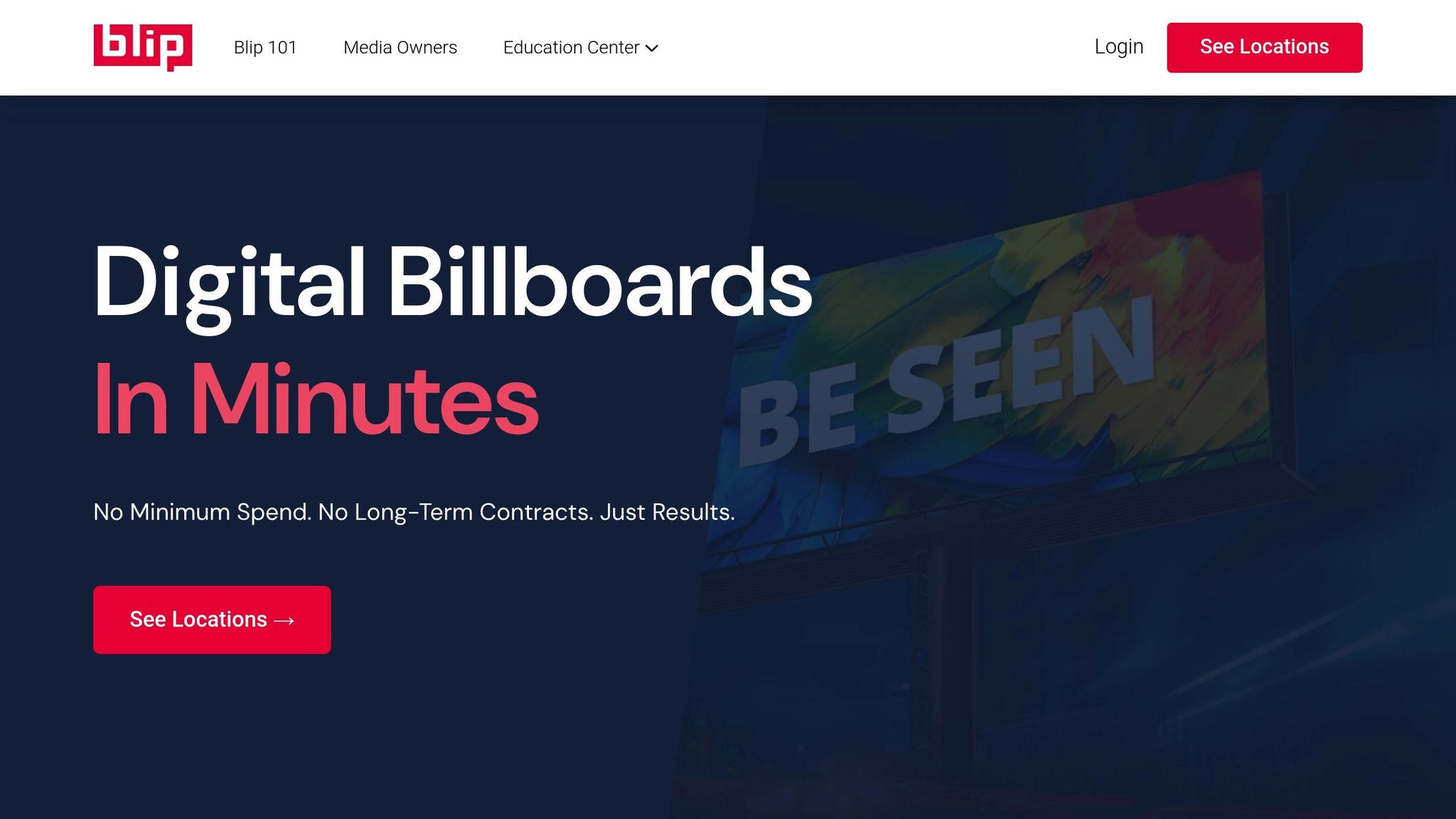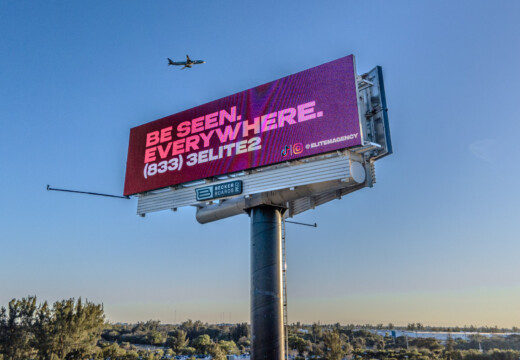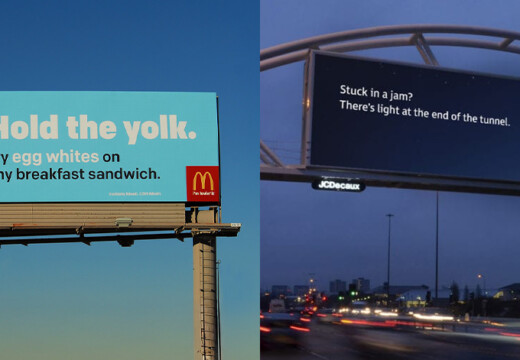Looking to choose between static and digital billboards? Here’s what you need to know:
- Static Billboards:
- Fixed message, visible 24/7 for weeks or months.
- Great for long-term branding and consistent exposure.
- Requires physical installation and updates, which take time.
- Real-Time Digital Billboards:
- Dynamic content that can change instantly.
- Tailored to time, weather, or events for higher engagement.
- Flexible pricing with options as low as $20/day.
Quick Comparison:
| Feature | Static Billboards | Real-Time Billboards |
|---|---|---|
| Content Updates | Manual, slow process | Instant, remote updates |
| Message Flexibility | Fixed | Dynamic, programmable |
| Cost | High upfront and rental | Flexible, pay-per-play |
| Engagement | Moderate | Up to 400% higher |
| Analytics | Basic traffic estimates | Real-time performance data |
Bottom Line:
Static billboards are reliable for steady messaging, while digital billboards offer unmatched flexibility, real-time updates, and advanced targeting. Choose based on your campaign goals and budget.
How Effective Are Digital Billboards?
Static vs. Real-Time Billboards: Core Differences
Understanding the differences between static and real-time billboards can help you make smarter decisions when planning outdoor advertising campaigns. These two formats vary widely in their technology, content management, and overall flexibility. Let’s break down how each one works.
How Static Billboards Work
Static billboards rely on printed visuals mounted on fixed structures. Since they require physical installation and updates, they’re best suited for campaigns with long-term, unchanging messages.
Here’s how the process typically works:
- Design and Production: Graphics are created at precise dimensions and high resolution to meet large-format printing standards.
- Material Selection: Durable, weather-resistant materials like vinyl are chosen to withstand outdoor conditions.
- Physical Installation: Crews manually install the printed materials onto the billboard structure.
- Fixed Duration: Campaigns run for set periods, with updates requiring manual replacement.
How Real-Time Billboards Work
Real-time, or digital, billboards use LED screens paired with cloud-based systems, making them a highly adaptable advertising solution. They bring a modern twist to outdoor marketing by allowing dynamic, on-the-fly content changes.
Key features include:
- Digital Screens: LED displays ensure visibility in various lighting conditions.
- Cloud Connectivity: Content can be managed and updated remotely.
- Scheduling Options: Messages can be programmed to appear at specific times, dates, or in response to triggers.
- Real-Time Updates: Content can be updated in minutes, offering unmatched agility.
“Billboards are one of the most impactful ways to advertise, and with Blip, you spend a fraction of what you would end up paying elsewhere.”
| Feature | Static Billboards | Real-Time Billboards |
|---|---|---|
| Content Updates | Requires physical replacement | Instant digital updates |
| Display Duration | Fixed until manually updated | Flexible and programmable |
| Weather Resistance | Durable materials required | Built-in environmental protection |
| Content Variety | Single, fixed message | Multiple rotating messages |
| Installation Time | Hours or days for setup | One-time hardware setup |
Next, we’ll dive into how these formats compare in terms of cost, audience engagement, and update speed, helping you determine which option aligns best with your marketing goals.
Comparing Costs
After exploring various billboard technologies, let’s dive into the financial side of things. Here’s a closer look at how the expenses stack up for static versus real-time billboard advertising.
Static Billboard Expenses
Static billboards come with steep upfront and recurring costs. Advertisers need to budget for design, printing, installation, and maintenance. On top of that, rentals typically require a commitment of 6 to 12 months. And if unexpected issues like weather damage or vandalism arise, additional expenses and delays can quickly pile up.
Real‑Time Billboard Expenses
Digital billboard advertising has introduced a more flexible pricing model. Here’s a breakdown comparing older digital systems to modern platforms:
| Cost Component | Older Digital Systems | Modern Platform |
|---|---|---|
| Minimum Spend | $3,000+ monthly | $20 daily |
| Contract Length | 3–12 months | No contracts |
| Content Updates | Included | Unlimited |
| Display Flexibility | Fixed slots | Pay‑per‑play |
“Billboards are one of the most impactful ways to advertise, and with Blip, you spend a fraction of what you would end up paying elsewhere”.
Modern platforms offer several key benefits that make real-time digital campaigns especially appealing:
- Budget control with low daily spending options
- No long-term commitments, providing flexibility
- Competitive pricing through real-time bidding
- Detailed analytics to track ROI and optimize campaigns
This shift in costs allows businesses to adapt their billboard strategies to match the pace and goals of their marketing campaigns.
Audience Impact
When it comes to billboard advertising, audience engagement plays a major role in determining campaign success. By comparing static and real-time billboard strategies, we can see how each uniquely connects with viewers and shapes their experiences. Let’s dive into how these approaches impact audience engagement.
Static Billboard Results
Static billboards shine when it comes to building brand recognition. Their consistent, unchanging messages allow for repeated exposure, which helps engrain the brand in the minds of daily commuters. This steady visibility is especially beneficial for local businesses looking to establish a strong presence in their community.
Research suggests that static billboards are most effective when they feature:
- Bold visuals with high-contrast colors to grab attention.
- Minimal text, ideally 7 words or fewer, for quick readability.
- Memorable taglines that stick with viewers.
- Clear location details to guide potential customers.
- Straightforward value propositions that communicate the core message instantly.
By sticking to these principles, static billboards can leave a lasting impression, even without the bells and whistles of digital technology.
Real-Time Billboard Results
Digital billboards, on the other hand, take engagement to a new level. They can deliver up to 400% higher engagement by offering dynamic, contextually relevant content that adapts to the moment.
Here’s a quick comparison of key factors:
| Impact Factor | Static Billboards | Digital Billboards |
|---|---|---|
| Engagement | Moderate through repetition | Up to 400% higher engagement |
| Message Flexibility | Fixed for weeks or months | Dynamic content rotation |
| Contextual Relevance | Limited to location-based targeting | Tailored to time, weather, and events |
| Measurement | Basic traffic estimates | Comprehensive analytics |
Digital billboards stand out by offering two major advantages:
Contextual Targeting: Advertisers can adjust messaging on the fly to resonate with specific audiences at the right time. Examples include:
- Promotions tailored to specific times of day.
- Weather-based messaging, like advertising hot drinks on a cold day.
- Aligning content with local events to boost relevance.
- Optimizing messages based on traffic patterns.
Performance Tracking: Unlike static billboards, digital platforms provide robust analytics to measure campaign success. These insights include:
- Real-time impression counts.
- Audience demographic breakdowns.
- Brand health measurements.
- Foot traffic analysis.
- Sales impact evaluations.
sbb-itb-2e2e93f
Content Management Speed
When it comes to advertising campaigns, the speed at which you can manage and update content is a game-changer. It directly influences how quickly campaigns can adapt to shifting market trends and audience needs.
Static Billboard Timeframes
Updating content on a static billboard is a slow and multi-step process. From designing and printing to scheduling and physically installing the new ad, the entire process can take weeks. Unexpected logistical hiccups can add even more delays. This makes static billboards a poor choice for campaigns that need to pivot quickly in response to market changes.
Real-Time Billboard Updates
Digital billboards, on the other hand, offer lightning-fast updates. Thanks to modern technology, advertisers can update content almost instantly. Automated systems handle tasks like scheduling, performance tracking, content integration, and approvals, streamlining the process from start to finish.
This speed allows advertisers to keep their messaging timely and impactful. With the ability to make quick changes, campaigns can:
- React to competitor actions
- Leverage trending topics to stay relevant
- Experiment with different messaging approaches
- Tailor content to local events or occasions
- Adapt to fluctuating inventory levels
This flexibility is a cornerstone of dynamic advertising strategies, which will be explored further in upcoming sections.
Blip: Digital Billboard Platform Features

The world of digital billboard advertising has come a long way, offering tools that allow advertisers to manage campaigns in real time. One standout example is Blip, a self-serve platform designed to make outdoor advertising simpler, more flexible, and results-driven.
Budget Control and Pricing
Blip’s pay-per-play pricing model changes the game for advertisers. Instead of committing to high upfront costs, businesses can start campaigns with as little as $20 per day. You only pay when your ad is displayed, making this a budget-friendly option for companies of all sizes.
Platform Tools
Blip’s platform is packed with features that simplify campaign management and maximize impact. Here’s a snapshot of its key tools:
| Tool | Function | Benefit |
|---|---|---|
| Interactive Map | Lets you pick locations using performance data | Helps target high-traffic, strategic areas |
| Real-time Bidding | Updates prices every 10 minutes | Ensures you’re getting competitive rates |
| Design Guidelines | Walks you through ad creation step-by-step | Makes sure your billboard stands out |
| Quick Moderation | Reviews ads within 90 minutes | Speeds up the time it takes to go live |
These features, combined with easy-to-use tools, give advertisers the ability to fine-tune their campaigns with precision.
Performance Tracking
Blip also provides detailed analytics to help advertisers measure success. With its tracking tools, you can monitor:
- Daily ad impressions
- Average CPM rates
- Performance by location
- ROI metrics for each campaign
This level of insight has delivered tangible results for businesses like Mr. Charlie’s Chicken Fingers, whose owner, Paul Willey, shared:
“Working with Blip has given Mr. Charlie’s the momentum to get our new location on the map while accelerating growth for our original location”.
With flexible pricing, user-friendly tools, and in-depth analytics, Blip is redefining outdoor advertising. It makes billboard campaigns more accessible and measurable compared to traditional static options.
Conclusion
Choosing between static and digital billboard content plays a key role in shaping your advertising approach, with each offering distinct advantages to meet different marketing needs. While static billboards ensure steady brand visibility, digital billboards have redefined outdoor advertising by introducing features like real-time updates, flexible scheduling, and measurable results.
The transition from static to digital reflects a major step forward in how businesses engage with their audiences. Digital billboards allow for dynamic content delivery and provide the flexibility to adjust campaigns on the go, all while offering detailed performance analytics to track success. Meanwhile, static billboards remain a reliable option for consistent, long-term messaging.
Digital billboard advertising stands out with its ability to update content instantly, manage campaigns efficiently, and track performance data – all at increasingly affordable costs. These advancements have opened the door for businesses of all sizes to leverage outdoor advertising in smarter, more effective ways.
This shift highlights a new era in outdoor advertising, equipping businesses with the tools to take control of their campaigns and achieve measurable impact.
FAQs
What should I consider when choosing between static and real-time digital billboard ads for my campaign?
When choosing between static and real-time digital billboard ads, it’s essential to consider your campaign’s purpose, budget, and the level of flexibility you need.
Static ads are a solid choice for delivering a consistent message over an extended period. They provide steady visibility and are perfect for building brand awareness or promoting offers that don’t need frequent updates.
On the flip side, real-time digital billboards allow for dynamic updates, making them a great fit for time-sensitive promotions, events, or campaigns that require frequent tweaks. Platforms like Blip make it simple to manage these ads, helping you reach specific audiences while staying within budget.
Think about how each type of ad fits into your overall strategy and how much control you want over your messaging.
How do the costs of static billboards compare to digital ones, and what should small businesses consider for their budget?
When it comes to advertising, static billboards often come with hefty upfront costs and require long-term commitments – something that can be tough for small businesses working with tight budgets. Digital billboards, however, provide a more budget-friendly and flexible alternative. Take platforms like Blip, for instance. They let businesses run campaigns starting at just $20 a day, with a pay-per-play model. This means you only pay for the ads that actually run, making it easier for small businesses to control spending while still reaching a broader audience.
How do real-time digital billboards create more engaging experiences compared to static billboards?
Real-Time Digital Billboards: A Game Changer for Advertising
Real-time digital billboards bring a whole new level of engagement by delivering dynamic, constantly updated content. Unlike static billboards that display the same message for weeks or even months, these digital displays can showcase timely updates – like weather conditions, upcoming local events, or limited-time promotions. This makes them far more relevant and eye-catching for passersby.
Another standout feature is their ability to adjust messaging throughout the day. Imagine a restaurant using a digital billboard to highlight breakfast specials during the morning rush and switching to dinner deals as the evening sets in. This adaptability ensures businesses can reach their audience with the right message at the perfect moment, creating a stronger connection and boosting the impact of their advertising efforts.
Related posts
When choosing between static and real-time digital billboard ads, it’s essential to consider your campaign's purpose, budget, and the level of flexibility you need.
Static ads are a solid choice for delivering a consistent message over an extended period. They provide steady visibility and are perfect for building brand awareness or promoting offers that don’t need frequent updates.
On the flip side, real-time digital billboards allow for dynamic updates, making them a great fit for time-sensitive promotions, events, or campaigns that require frequent tweaks. Platforms like Blip make it simple to manage these ads, helping you reach specific audiences while staying within budget.
Think about how each type of ad fits into your overall strategy and how much control you want over your messaging.
"}},{"@type":"Question","name":"How do the costs of static billboards compare to digital ones, and what should small businesses consider for their budget?","acceptedAnswer":{"@type":"Answer","text":"
When it comes to advertising, static billboards often come with hefty upfront costs and require long-term commitments - something that can be tough for small businesses working with tight budgets. Digital billboards, however, provide a more budget-friendly and flexible alternative. Take platforms like Blip, for instance. They let businesses run campaigns starting at just $20 a day, with a pay-per-play model. This means you only pay for the ads that actually run, making it easier for small businesses to control spending while still reaching a broader audience.
"}},{"@type":"Question","name":"How do real-time digital billboards create more engaging experiences compared to static billboards?","acceptedAnswer":{"@type":"Answer","text":"
Real-Time Digital Billboards: A Game Changer for Advertising
Real-time digital billboards bring a whole new level of engagement by delivering dynamic, constantly updated content. Unlike static billboards that display the same message for weeks or even months, these digital displays can showcase timely updates - like weather conditions, upcoming local events, or limited-time promotions. This makes them far more relevant and eye-catching for passersby.
Another standout feature is their ability to adjust messaging throughout the day. Imagine a restaurant using a digital billboard to highlight breakfast specials during the morning rush and switching to dinner deals as the evening sets in. This adaptability ensures businesses can reach their audience with the right message at the perfect moment, creating a stronger connection and boosting the impact of their advertising efforts.
"}}]}


